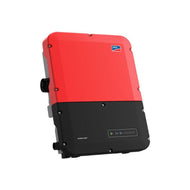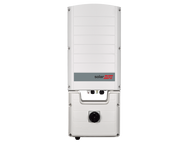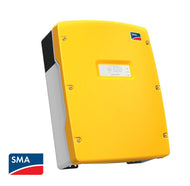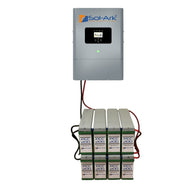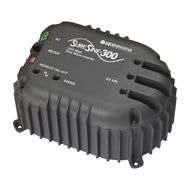About Solar Inverter
Basics Of Solar Energy
A house, a business unit, a block or a city all require energy. Solar energy is a scalable solution to satisfy the residential, commercial and even industrial needs for clean and sustainable power. A solar PV (photovoltaic) system includes the PV modules (solar panels), solar inverter, battery storage, and anything required to operate these components. Solar power systems seamlessly integrate into existing power grids in accordance with all standards of certifications with IP65 & IP67.
Solar Inverter:
After solar panels, the most crucial component of a solar power system is an solar inverter. It is often called the “heart” of the system, and acts as an interface which converts DC power produced by solar panels into AC power that can be consumed in a residential or commercial property. The type of inverter being used depends on the size of the system as well as whether it’s grid-tied or off-grid.
Grid-tied solar PV systems need high-efficiency solar inverters that can feed power from solar panels directly to the utility grid. These grid-tied systems are designed to quickly disconnect from the utility grid if the power goes out, and this safety feature is called anti-islanding. Anti-islanding is important because it protects utility workers fixing the grid from excess power being generated by solar power systems.
Off-grid solar PV systems need different kind of high-efficiency solar inverters that can charge batteries both from power gathered by the solar panels and also from grid power. Some of the better-quality inverters also have built in MPPT (Maximum Power Point Tracking) charge controllers that can extract up to 30% more power from the solar panels. Charge controllers are required to block reverse current and to prevent overcharging the batteries.
There are a wide variety of solar inverters ranging from individual micro inverters to single-phase and three-phase string inverters for residential or commercial applications. They even grow in size all the way up to megawatt-sized central inverters for solar farms that can power small towns and cities.
Grid-Tied or On-Grid System
Grid-tied solar PV systems are designed to work in conjunction with the utility grid where excess generated electricity is fed back to the grid. A net meter is installed along with this system to keep track of the electricity consumed versus the electricity generated, and any excess power fed back to the grid results in savings reflected on the utility bill. Please note this type of solar PV system does not work when the grid is down due to anti-islanding safety features built into the inverters. Grid-tied systems are the least expensive and most popular solar PV system.
Off-Grid System
Off-grid solar PV systems store the electricity generated (both from PV modules and the grid) in batteries and utilize that same stored energy by converting it back to AC when required. The rising cost of fossil fuels and the increasing demand for electricity, especially in areas where there is no grid or where the grid is inconsistent, has resulted in increased demand for off-grid solar PV systems. The reduction in battery costs over the years has further brought the system cost down.
Single-Phase Solar Inverters
A single-phase inverter is required when installing a solar PV system to supply power to a single-phase network. An inverter takes DC electricity produced by the solar modules and converts it into an AC waveform. Most inverters come with the ability to be grid-tied, meaning that they can produce a waveform suitable for a parallel connection to the public network, containing the necessary protocols for safety.
Three-Phase Solar Inverters
Three-phase inverters are used for variable-frequency drive applications and for high power applications such as HVDC (high voltage direct current) power transmission. A basic three-phase inverter consists of three single-phase inverter switches each connected to one of the three load terminals. For the most basic control scheme, the operation of the three switches is coordinated so that one switch operates at each 60 degree point of the fundamental output waveform. This creates a line-to-line output waveform that has six steps. The six-step waveform has a zero-voltage step between the positive and negative sections of the square-wave such that the harmonics that are multiples of three are eliminated. When carrier-based PWM (pulse width modulation) techniques are applied to six-step waveforms, the basic overall shape, or envelope, of the waveform is retained so that the 3rd harmonic and its multiples are cancelled.
5 Things to Keep in Mind While Choosing Solar Inverter
- Choose the Right Capacity Of Solar Inverter.
- Check with your state subsidy on Solar.
- Check the availability of grid in your area, so you can decide for “On Grid or Off Grid” Solar Inverter.
-
Check your meter phase whether its single phase or three phase depending upon that you can decide on single phase solar inverter or three phase solar inverter.
- Check the whether you need a solar storage or not. You can store solar energy in solar batteries attached with solar inverter.

 Bifacial
Bifacial Mono Crystalline
Mono Crystalline Poly Crystalline
Poly Crystalline Thin Film
Thin Film Foldable Solar Panel
Foldable Solar Panel Residential On Grid
Residential On Grid Commercial On Grid
Commercial On Grid Solar Storage / Hybrid Inverter
Solar Storage / Hybrid Inverter Solar Battery Inverter
Solar Battery Inverter RV Off Grid Solar Inverter
RV Off Grid Solar Inverter Lithium ion Batteries
Lithium ion Batteries AGM Batteries
AGM Batteries Lead Acid Batteries
Lead Acid Batteries Lithium Batteries
Lithium Batteries Lead Carbon Batteries
Lead Carbon Batteries Deep Cycle Flooded Battery
Deep Cycle Flooded Battery Solar Workstation
Solar Workstation Solar Security Camera
Solar Security Camera Solar Freezer
Solar Freezer Battery Charger
Battery Charger Meters
Meters Distribution Panel
Distribution Panel Battery
Battery Invertor Charger
Invertor Charger Breaker Panel
Breaker Panel